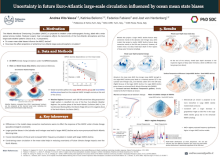The role of SST mean state biases in projected Euro-Atlantic atmospheric circulation
Andrea Vito
Vacca
Politecnico di Torino & IUSS Pavia
Poster
Understanding how a warmer climate will affect atmospheric circulation in the northern mid-latitudes is of great interest, as circulation patterns are directly linked to regional impacts and extreme weather events. While recent research has shown the importance of ocean forcing on extratropical atmospheric dynamics at multiple timescales, the impact of changes in ocean circulation on the inter-model spread in future projections of large-scale weather patterns is unknown.
Here we investigate the importance of mean state biases on wintertime Euro-Atlantic Weather Regimes (WRs). WRs are recurrent day-to-day patterns of large-scale atmospheric circulation over the ocean, which directly impact temperature and precipitation over the surrounding continents. Over the Euro-Atlantic sector the four main WRs are: positive/negative phase of the North Atlantic Oscillation (NAO), Scandinavian Blocking, and Atlantic Ridge.
We first assess the representation of WRs in the CMIP6 archive. While large frequency biases could underpin the reliability of future projections, we find a stronger correlation with biases in the mean state of SSTs in the subpolar North Atlantic (SPNA), which in projections of future climate change is strongly affected by the weakening of the Atlantic Meridional Overturning Circulation (AMOC). The influence of SST biases and AMOC also affects projections of future climate change, as models that simulate a larger AMOC decline (reduced SPNA warming) feature a net increase in the NAO+ regime frequency compared to models that simulate a smaller AMOC decline (enhanced SPNA warming), while SBL more strongly decreases.
We thus demonstrate that differences in the frequency of future phases of WRs strongly depend upon changes in regional SSTs over the SPNA. Mechanistically, this is due to the influence of SPNA SST on mean geopotential height. Models featuring a warmer SPNA in the mean climate are associated with a stronger AMOC decline and reduced SPNA warming in the 21st century. This leads to a relatively smaller increase in mean geopotential height. On the other hand, models featuring a colder SPNA in the mean climate are associated with weaker AMOC decline but enhanced SPNA warming in the 21st century, which leads to larger increase in the geopotential height. This explains why NAO+ increases in the 21st century, but much more in the models with a stronger AMOC decline.
Overall our findings suggest a strong dependence of WRs on biases in the mean climate. Hence, to be able to accurately make predictions about the future of WRs we need to be able to better simulate the mean climate.
Here we investigate the importance of mean state biases on wintertime Euro-Atlantic Weather Regimes (WRs). WRs are recurrent day-to-day patterns of large-scale atmospheric circulation over the ocean, which directly impact temperature and precipitation over the surrounding continents. Over the Euro-Atlantic sector the four main WRs are: positive/negative phase of the North Atlantic Oscillation (NAO), Scandinavian Blocking, and Atlantic Ridge.
We first assess the representation of WRs in the CMIP6 archive. While large frequency biases could underpin the reliability of future projections, we find a stronger correlation with biases in the mean state of SSTs in the subpolar North Atlantic (SPNA), which in projections of future climate change is strongly affected by the weakening of the Atlantic Meridional Overturning Circulation (AMOC). The influence of SST biases and AMOC also affects projections of future climate change, as models that simulate a larger AMOC decline (reduced SPNA warming) feature a net increase in the NAO+ regime frequency compared to models that simulate a smaller AMOC decline (enhanced SPNA warming), while SBL more strongly decreases.
We thus demonstrate that differences in the frequency of future phases of WRs strongly depend upon changes in regional SSTs over the SPNA. Mechanistically, this is due to the influence of SPNA SST on mean geopotential height. Models featuring a warmer SPNA in the mean climate are associated with a stronger AMOC decline and reduced SPNA warming in the 21st century. This leads to a relatively smaller increase in mean geopotential height. On the other hand, models featuring a colder SPNA in the mean climate are associated with weaker AMOC decline but enhanced SPNA warming in the 21st century, which leads to larger increase in the geopotential height. This explains why NAO+ increases in the 21st century, but much more in the models with a stronger AMOC decline.
Overall our findings suggest a strong dependence of WRs on biases in the mean climate. Hence, to be able to accurately make predictions about the future of WRs we need to be able to better simulate the mean climate.

Poster file
vacca-andrea-confronting-poster.pdf
(1.6 MB)
